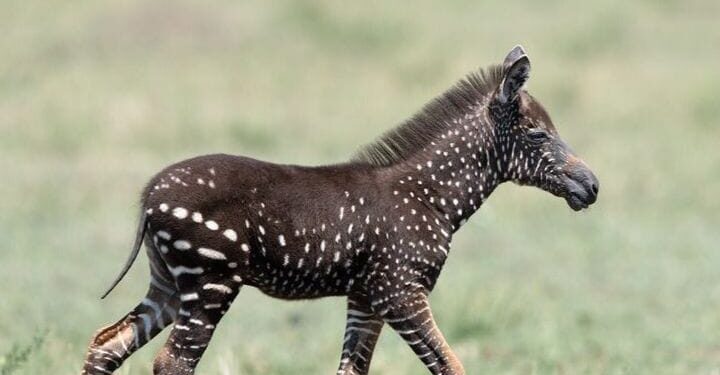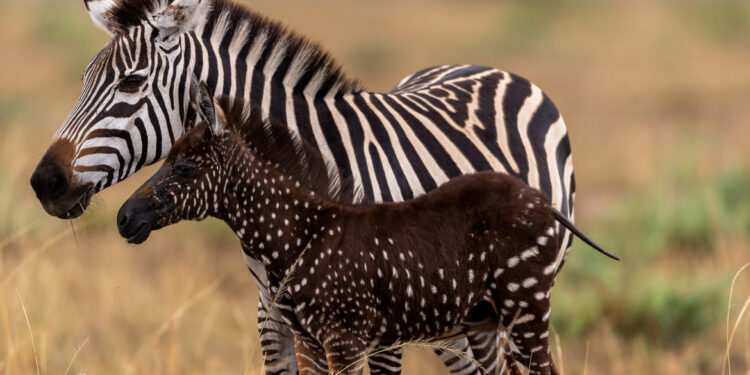Fresh details have emerged about a beautiful zebra spotted in Kenya that left Netizens amazed about the rare, amazing gem.
This is after a post of the black coated zebra with white polka dots surfaced online on December 27, amazing users who had never seen such a rare occurrence.
Notably, the post has since amassed a good number of engagements, with netizens excited about the beautiful foal.
According to the post, the rare foal was spotted at the Maasai Mara game reserve in Kenya.
However, The Kenya Times has since established that the rare zebra named Tira, was actually first spotted back in 2019.
In addition, the rare skin color is as a result of a genetic disorder which makes Tira stand out among normal zebras.

With Kenyans online proud for having such a wonder in their own background, here are the details you need to know about the rare gem.
Genetic Disorder
According to the National Geographic, Tira suffers from a genetic condition called pseudomelanism.
In addition, the rare genetic mutation is responsible for the abnormalities displayed within the animal’s stripe pattern.
Frank Liu, the wildlife photographer who took the first ever shot, further adds that Zebra stripes are unique.
“Zebra stripes are as unique as fingerprints, but Tira’s odd coloration could be the first recorded observation in the Masai Mara,” adds Liu.
Also Read: Understanding Wildlife Crimes, Cost and Control Measures
Additionally, National Geographic reveals that Zebras also experience other unusual color variations.
This include partial albinism, which has been spotted in a Zebra in Tanzania’s Serengeti National Park.
Discovery of the Rare Zebra
The first ever shot of Tira was taken by wildlife photographer Frank Liu back in 2019.
Amazed by the wonderful discovery, Liu went on to share the beautiful photos taken at the Maasai Mara Game reserve.
In addition, the photographer disclosed that the genetically mutated eye-catching foal was discovered by a Maasai guide.
“Last night, a Maasai guide discovered a one-of-a-kind baby Zebra and named it after his surname, Tira,” added Liu.
Following the discovery by Antony Tira, Liu was among the first ones to visit Tira and enjoy the beautiful, rare scene.

He further noted that such incidences had earlier been recorded in countries such as Botwsana.
“The similar case recorded earlier was different cause it still maintained a brush-like tail and stripes,” noted the photographer.
However, in Tira’s case, the patterns on the black coat appear as polka dots as it can be seen from Liu’s amazing shots of the eye-catching Tira.
A video further shows the rare gem, who was a week old at the time, feeding with other normal zebras.
Survival Quest
According to Larison Research, Tira’s future is likely uncertain.
“Research on other species has shown that, while it is harder for a predator to target an individual in a group, it is easier if an individual is different,” says part of the research.
Also Read: Alfred Mutua Announces Free Entry to All National Parks
The research further notes that most zebras with such unusual coloration probably don’t survive long.
Larison further notes, “I have seen several photos of foals with this specific pattern over the years.”
However, in what could be discouraging news for Tira, only one photo—from the ‘50s was the zebra either a juvenile or adult.
Nevertheless, the Research also notes that the rare genetic mutation poses a risk from biting flies.
“Zebra stripes have evolved over the years, with experiments in the field showing that biting flies don’t like landing on striped surfaces,” notes Larison.
Unfortunately for Tira the revelations put him at risk of diseases like equine influenza caused by flies.
The amazing, mutated skin decreases his repel against flies compared to a normally striped zebra.
National Geographic further notes that keeping track of such equine aberrations is useful to science.
The television network adds, “It is useful as part of a broader goal to monitor changes in species and how they’re managed by local communities.”











































































